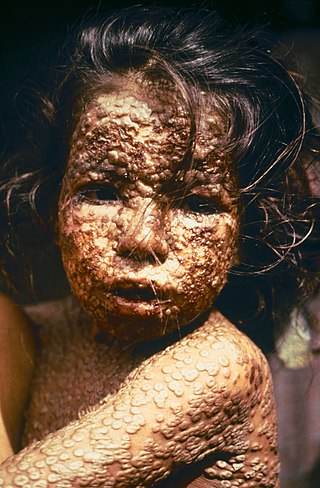
The smallpox vaccine is the first vaccine to have been developed against a contagious disease. In 1796, British physician Edward Jenner demonstrated that an infection with the relatively mild cowpox virus conferred immunity against the deadly smallpox virus. Cowpox served as a natural vaccine until the modern smallpox vaccine emerged in the 20th century. From 1958 to 1977, the World Health Organization (WHO) conducted a global vaccination campaign that eradicated smallpox, making it the only human disease to be eradicated. Although routine smallpox vaccination is no longer performed on the general public, the vaccine is still being produced to guard against bioterrorism, biological warfare, and mpox.

The New World of the Western Hemisphere was devastated by the 1775–1782 North American smallpox epidemic. Estimates based on remnant settlements say at least 130,000 people were estimated to have died in the epidemic that started in 1775.

The 1978 smallpox outbreak in the United Kingdom resulted in the death of Janet Parker, a British medical photographer, who became the last recorded person to die from smallpox. Her illness and death, which was connected to the deaths of two other people, led to the Shooter Inquiry, an official investigation by government-appointed experts triggering radical changes in how dangerous pathogens were studied in the UK and named after the panel's leader.

The Killer That Stalked New York is a 1950 American film noir directed by Earl McEvoy and starring Evelyn Keyes, Charles Korvin and William Bishop. The film, shot on location and in a semi-documentary style, is about diamond smugglers who unknowingly start a smallpox outbreak in the New York City of 1947. It is based on the real threat of a smallpox epidemic in the city, as described in a story taken from a 1948 Cosmopolitan magazine article.

Rahima Banu Begum is the last known person to have been infected with naturally occurring Variola major smallpox, the more deadly variety of the disease.

Ali Maow Maalin was a Somali hospital cook and health worker from Merca who is the last person known to have been infected with naturally occurring Variola minor smallpox. He was diagnosed with the disease in October 1977 and made a full recovery. Although he had many contacts, none of them developed the disease, and an aggressive containment campaign was successful in preventing an outbreak. Smallpox was declared to have been eradicated globally by the World Health Organization (WHO) two years later. Maalin was subsequently involved in the successful poliomyelitis eradication campaign in Somalia, and he died of malaria while carrying out polio vaccinations after the re-emergence of the poliovirus in 2013.

Variola Vera is a 1982 Yugoslav film directed by Goran Marković.
Mass vaccination is a public policy effort to vaccinate a large number of people, possibly the entire population of the world or of a country or region, within a short period of time. This policy may be directed during a pandemic, when there is a localized outbreak or scare of a disease for which a vaccine exists, or when a new vaccine is invented.

Smallpox was an infectious disease caused by variola virus, which belongs to the genus Orthopoxvirus. The last naturally occurring case was diagnosed in October 1977, and the World Health Organization (WHO) certified the global eradication of the disease in 1980, making smallpox the only human disease to have been eradicated to date.

The 1974 smallpox epidemic in India infected 188,000 people, leading to the deaths of 31,000 Indians.
The history of smallpox extends into pre-history. Genetic evidence suggests that the smallpox virus emerged 3,000 to 4,000 years ago. Prior to that, similar ancestral viruses circulated, but possibly only in other mammals, and possibly with different symptoms. Only a few written reports dating from about 500 AD to 1000 AD are considered reliable historical descriptions of smallpox, so understanding of the disease prior to that has relied on genetics and archaeology. However, during the 2nd millennium AD, especially starting in the 16th century, reliable written reports become more common. The earliest physical evidence of smallpox is found in the Egyptian mummies of people who died some 3,000 years ago. Smallpox has had a major impact on world history, not least because indigenous populations of regions where smallpox was non-native, such as the Americas and Australia, were rapidly and greatly reduced by smallpox during periods of initial foreign contact, which helped pave the way for conquest and colonization. During the 18th century the disease killed an estimated 400,000 Europeans each year, including five reigning monarchs, and was responsible for a third of all blindness. Between 20 and 60% of all those infected—and over 80% of infected children—died from the disease.
Operation Dark Winter was the code name for a senior-level bio-terrorist attack simulation conducted on June 22–23, 2001. It was designed to carry out a mock version of a covert and widespread smallpox attack on the United States. Tara O'Toole and Tom Inglesby of the Johns Hopkins Center for Civilian Biodefense Strategies (CCBS) / Center for Strategic and International Studies (CSIS), and Randy Larsen and Mark DeMier of Analytic Services were the principal designers, authors, and controllers of the Dark Winter project.
The Aral smallpox incident was a 30 July 1971 outbreak of the viral disease which occurred as a result of a field test at a Soviet biological weapons (BW) facility on an island in the Aral Sea. The incident sickened ten people, of whom three died, and came to widespread public notice only in 2002.
The Massachusetts smallpox epidemic or colonial epidemic was a smallpox outbreak that hit Massachusetts in 1633. Smallpox outbreaks were not confined to 1633 however, and occurred nearly every ten years. Smallpox was caused by two different types of variola viruses: variola major and variola minor. The disease was hypothesized to be transmitted due to an increase in the immigration of European settlers to the region who brought Old World smallpox aboard their ships.
The smallpox virus retention debate has been going on among scientists and health officials since the smallpox virus was declared eradicated by the World Health Organization (WHO) in 1980. The debate centers on whether or not the last two known remnants of the Variola virus known to cause smallpox, which are kept in tightly controlled government laboratories in the United States and Russia, should be finally and irreversibly destroyed. Advocates of final destruction maintain that there is no longer any valid rationale for retaining the samples, which pose the hazard of escaping the laboratories, while opponents of destruction maintain that the samples may still be of value to scientific research, especially since variants of the smallpox virus may still exist in the natural world and thus present the possibility of the disease re-emerging in the future or being used as a bio-weapon.

Ring vaccination is a strategy to inhibit the spread of a disease by vaccinating those who are most likely to be infected.

In 1721, Boston experienced its worst outbreak of smallpox. 5,759 people out of around 10,600 in Boston were infected and 844 were recorded to have died between April 1721 and February 1722. The outbreak motivated Puritan minister Cotton Mather and physician Zabdiel Boylston to variolate hundreds of Bostonians as part of the Thirteen Colonies' earliest experiment with public inoculation. Their efforts would inspire further research for immunizing people from smallpox, placing the Massachusetts Bay Colony at the epicenter of the Colonies' first inoculation debate and changing Western society's medical treatment of the disease. The outbreak also altered social and religious public discourse about disease, as Boston's newspapers published various pamphlets opposing and supporting the inoculation efforts.
The 1924–1925 Minnesota smallpox epidemic was the deadliest outbreak of smallpox in the U.S. state of Minnesota. 500 people died—400 of them in the Minneapolis–Saint Paul metropolitan area. Almost 90 percent of the Twin Cities deaths took place in Minneapolis.

An outbreak of smallpox occurred in the city of Wrocław in Poland in the summer of 1963. The disease was brought to Poland by an officer in the Ministry of Public Security who had returned from India. The epidemic lasted for two months, causing 99 people to fall ill and seven to die. It caused Wrocław to close and quarantine itself.

Mahendra Dutta was an Indian public health official, best known for his efforts to eradicate smallpox in India as the appraisal officer for smallpox in Bihar during the 1974 epidemic. He later served as Health Commissioner of New Delhi, Chief Epidemiologist of the National Centre for Disease Control, and Deputy Director General of the Ministry of Health and Family Welfare's public health operations. Additionally, he was a founding member of the Indian Public Health Association, serving as its president in 1987. Dutta's career is featured in an episode of Céline Gounder's 2023 podcast series Epidemic: Eradicating Smallpox.














